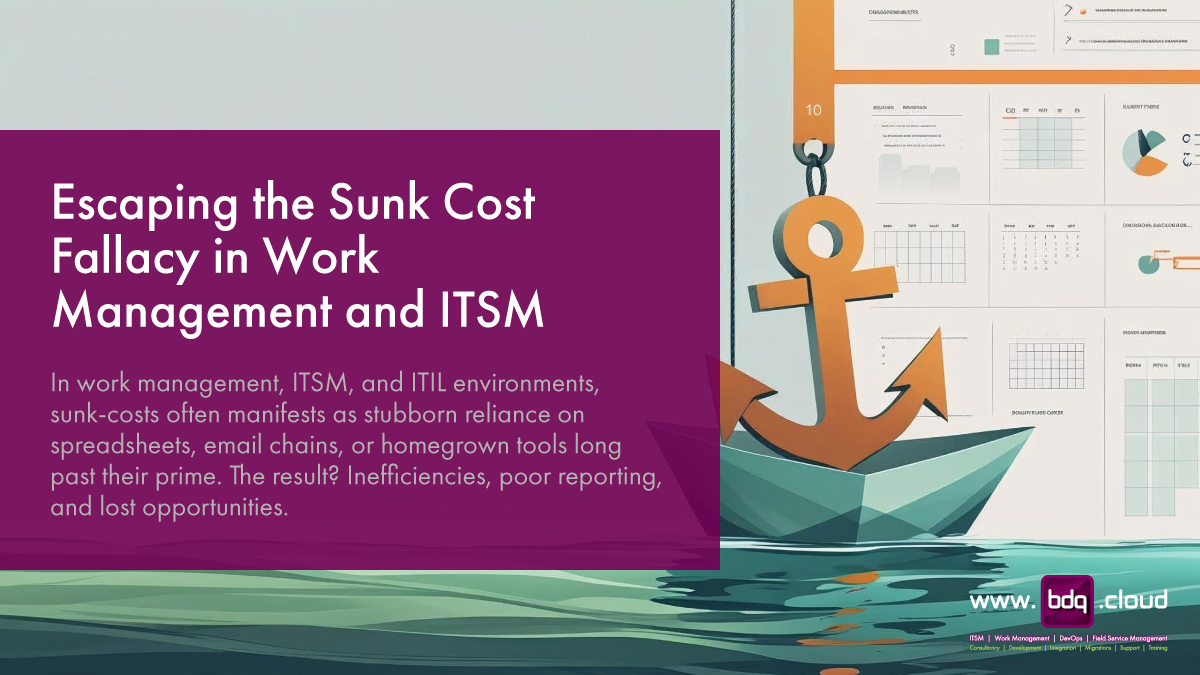7 min read
Escaping the Sunk Cost Fallacy in Work Management and ITSM
By: Scott Hirst on 03 Jul 2025

In the world of business operations, clinging to outdated or inefficient tools can quietly drain resources, stifle progress, and lead to mounting frustration. This common psychological trap is known as the sunk cost fallacy - continuing with a decision based on prior investment, even when better options are available.
Understanding the Sunk Cost Fallacy
The sunk cost fallacy occurs when organizations continue investing in a project or system simply because they’ve already spent money, time, or effort on it - even when it's no longer serving them. According to Asana's insight on the topic, this fallacy can deeply affect strategic decision-making by anchoring teams to past choices instead of focusing on future gains.
In work management, ITSM, and ITIL environments, this often manifests as stubborn reliance on spreadsheets, email chains, or homegrown tools long past their prime. The result? Inefficiencies, poor reporting, and lost opportunities.
An analysis by Cornell University of 1,471 IT projects found that, on average, costs overran by 27%. Notably, one in six projects experienced cost overruns of 200% and schedule overruns of nearly 70%, often due to continued investment in failing initiatives influenced by sunk cost considerations.
Studies have shown that the larger the loss, the higher the sunk-cost bias is. In other words, the more you have already "invested," the less likely you are to shift gears and walk away.
Real-World Examples: BDQ’s Clients Who Moved Forward
BDQ has helped numerous organizations break free from the sunk cost mindset by implementing scalable, modern solutions. For example:
PartnerHero – Migrating from Monday.com to Jira Work Management
PartnerHero realized that maintaining work in two separate tools - Monday.com for business and Jira Software for development - was creating silos. Rather than sticking with the familiar but fragmented setup, they partnered with BDQ to consolidate into Jira. This provided unified reporting, streamlined operations, and long-term efficiency.
READ MORE →
The Wine Society – Replacing a Legacy ITSM Desk with Jira Service Management
Faced with a legacy helpdesk system that lacked meaningful reporting or workflow, The Wine Society chose to replace it with Jira Service Management. Despite prior investment in the legacy system, they embraced a future-focused solution that enabled clear SLA tracking and improved collaboration across development and support teams.
READ MORE →
Employ HR Pro – Escaping Spreadsheet Chaos with Asana
Employ HR Pro was overwhelmed by spreadsheet-based workflows for client projects. BDQ implemented Asana to bring visibility, automation, and consistency. The result? An estimated savings of over 182 hours of admin time per person per year - proof that walking away from sunk costs pays off.
READ MORE →
Why BDQ?
At BDQ, we understand that change can be daunting. But we also know that sticking with inefficient systems out of habit - or because “we’ve already paid for it” - is a recipe for stagnation.
We help clients identify pain points, design future-ready systems, and implement solutions using industry-leading platforms:
-
Atlassian Jira and Jira Service Management – Ideal for ITIL and ITSM processes with robust change, incident, and service request handling.
-
Asana and Monday.com – Best-in-class tools for team collaboration, project tracking, and dynamic goal management.
-
Zephyr – Powerful test management fully integrated with Jira for automated and manual QA reporting.
-
Tempo – Advanced time tracking, reporting, and capacity planning directly within Jira.
-
GLPI – A versatile open-source ITSM platform that supports asset management, ticketing, and change control.
-
Atomicwork – An AI-powered service management platform built to streamline employee support, automate workflows, and enhance IT and HR operations.
-
HaloITSM – A modern, flexible ITSM tool designed to support ITIL-aligned practices across incident, problem, change, and asset management, with a highly customizable interface for enterprise needs.
With BDQ’s Accelerated Implementation Methodology (AIM), we ensure fast delivery, transparent collaboration, and solutions that align with your business objectives, not your past investments.
It's Time to Make a Smart Decision
Clinging to outdated systems only deepens the problem. Embracing change and focusing on return, not sunk costs, sets the stage for agility, efficiency, and growth.
💬 We Want to Hear From You!
Have you experienced the sunk cost fallacy in your organization? What decisions are you putting off because of past investments?
Share your story in the comments or get in touch with us to learn how BDQ can help you break free from legacy systems and invest in your success.
Related Posts
How to Keep Your On-Premise Service Management Running Strong
Across the IT landscape, the trend is clear: many software vendors are ending support for...
BDQ are proud to announce that we are official partners of monday.com
We are thrilled to announce that BDQ.cloud has officially become a valued partner of monday.com!
BDQ Partners with Freshworks to Deliver Smarter Service Solutions
We’re excited to share that BDQ is now an official Freshworks Partner!



